Herbs can be used in many different ways. Simplest of all is nibbling on the fresh plant, crushing the leaves to apply them as a poultice or perhaps boiling up some leaves as a tea. Many of the plants discussed in this book are foods as well as medicines, and incorporating them seasonally in your diet is a tasty and enjoyable way to improve your health.
But because fresh herbs aren’t available year round or may not grow right on your doorstep, you may want to preserve them for later use. Follow these guidelines.
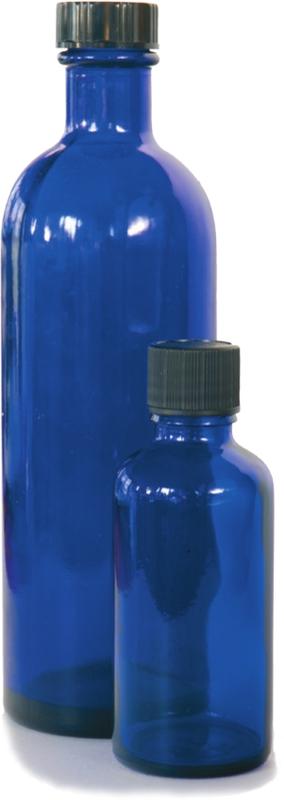
Equipment needed
You don’t need any special equipment for making your own hedgerow medicines. You probably already have most of what you need. Kitchen basics like a teapot, measuring jugs, saucepans and a blender are all useful, as are jam-making supplies such as a jelly bag and jam jars. A mortar and pestle are useful but not essential. You’ll also need jars and bottles, and labels for these.
There is a list of suppliers at the end of the book to help you source any supplies or ingredients you may need (see page 202).
It is a good idea to have a notebook to write down your experiences, so you’ll have a record for yourself and can repeat successes. Who knows, it could become a future family heirloom like the stillroom books of old!
Drying herbs
The simplest way to preserve a plant is to dry it, and then use the dried part as a tea (infusion or decoction: see opposite). Dried plant material can also go into tinctures, infused oils and other preparations, though these are often made directly from fresh plants.
To dry herbs, tie them in small bundles and hang these from the rafters or a laundry airer, or spread the herbs on a sheet of brown paper or a screen. (Avoid using newspaper as the inks contain toxic chemicals.) You can easily make your own drying screen by stapling some mosquito netting or other open-weave fabric to a wooden frame. This is ideal, as the air can circulate around the plant, and yet you won’t lose any small flowers or leaves that are loose.
Generally, plants are best dried out of the sun. An airing cupboard works well, particularly in damp weather.
Storing dried herbs
Once the plant is crisply dry, you can discard any larger stalks. Whole leaves and flowers will keep best, but if they are large you may want to crumble them so they take up less space. They will be easier to measure for teas etc. if they are crumbled before use.
Dried herbs can be stored in brown paper bags or in airtight containers such as sweet jars or plastic tubs, in a cool place. If your container is made of clear glass or other transparent material, keep it in the dark as light will fade leaves and flowers quite quickly. Brown glass jars are excellent – we have happily worked our way through quantities of hot chocolate in order to build up a collection of these!
Dried herbs will usually keep for a year, until you can replace them with a fresh harvest. Roots and bark keep longer than leaves and flowers.
Teas: infusions and decoctions
The simplest way to make a plant extract is with hot water. Use fresh or dried herbs. An infusion, where hot water is poured over the herb and left to steep for several minutes, is the usual method for a tea of leaves and flowers.

Part of a summer’s hedgerow harvest: (from left) St John’s wort in olive oil; dried mugwort; dandelion flower oil; raspberry vinegar; meadowsweet ghee; meadowsweet, mugwort and mint in white wine; rosehip oxymel
A decoction, where the herb is simmered or boiled in water for some time, is needed for roots and bark. Infusions and decoctions can also be used as mouthwashes, gargles, eyebaths, fomentations and douches.
Tinctures
While the term tincture can refer to any liquid extract of a plant, what is usually meant is an alcohol and water extract. Many plant constituents dissolve more easily in a mixture of alcohol and water than in pure water. There is the added advantage of the alcohol being a preservative, allowing the extract to be stored for several years. The alcohol content of the finished extract needs to be at least 20% to adequately preserve it. Most commercially produced tinctures have a minimum alcohol content of 25%. A higher concentration is needed to extract more resinous substances, such as myrrh resin.
For making your own tinctures, vodka is preferred as it has no flavour of its own, and allows the taste of the herbs to come through. Whisky, brandy or rum work quite well too. Wine is good, especially for dried herbs, but will not have as long a shelf life.

To make a tincture, you simply fill a jar with the herb and top up with alcohol, or you can put the whole lot in the blender first. The mixture is then kept out of the light for anything from a day to a month to infuse before being strained and bottled. Tinctures are convenient to store and to take. We find amber or blue glass jars best for keeping, although clear bottles will let you enjoy the colours of your tinctures. Store them in a cool place. Kept properly, most tinctures have a shelf life of around five years. They are rapidly absorbed into the bloodstream, and alcohol makes the herbal preparation more heating and dispersing in its effect.
Wines and beers
Many herbs can be brewed into wines and beers, which will retain the medicinal virtues of the plants. Elderberry wine and nettle beer are traditional, but don’t forget that ordinary beer is brewed with hops, a medicinal plant.
Glycerites
Vegetable glycerine is extracted from palm or other oil, and is a sweet, syrupy substance. It is particularly good in making medicines for children, and for soothing preparations intended for the throat and digestive tract, or coughs. A glycerite will keep well as long as the concentration of glycerine is at least 50% to 60% in the finished product.
Glycerine does not extract most plant constituents as well as alcohol does, but is effective for flowers such as red poppies, roses and St John’s wort. Glycerites are made the same way as tinctures, except the jar is kept in the sun or in a warm place to infuse.
Glycerine is a good preservative for fresh plant juices, in which half fresh plant juice and half glycerine are mixed, as it keeps the juice green and in suspension better than alcohol. This preparation is called a succus.
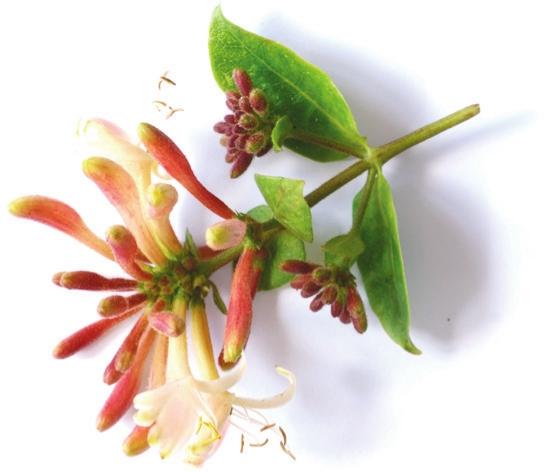
Vinegars
Another way to extract and preserve plant material is to use vinegar. Some plant constituents extract better in an acidic medium, making vinegar the perfect choice. Herbal vinegars are often made from pleasant-tasting herbs, and used in salad dressings and for cooking. They are also a good addition to the bath or for rinsing hair, as the acetic acid of the vinegar helps restore the natural protective acid pH of the body’s exterior. Cider vinegar is a remedy for colds and other viruses, so it is a good solvent for herbs for these conditions.
Herbal honeys
Honey has natural antibiotic and antiseptic properties, so is an excellent vehicle for medicines to fight infection. It can be applied topically to wounds and burns. Local honey can help prevent hayfever attacks.
Honey is naturally sweet, making it palatable for medicines for children. It is also particularly suited to medicines for the throat and respiratory system as it is soothing and also clears congestion. Herb-infused honeys are made the same way as glycerites, or can be gently heated in a bain-marie.
Oxymels
An oxymel is a preparation of honey and vinegar. Oxymels were once popular as cordials, both in Middle Eastern and European traditions. They are particularly good for cold and ’flu remedies. Honey can be added to a herb-infused vinegar, or an infused honey can be used as well.
Electuaries
Make these by stirring powdered dried herbs into honey or glycerine to make a paste. Electuaries are good as children’s remedies, and are often used to soothe the digestive tract. This is also a good way to prepare tonic herbs.
Syrups
Syrups are made by boiling the herb with sugar and water. The sugar acts as a preservative, and can help extract the plant material. Syrups generally keep well, especially the thicker ones containing more sugar, as long as they are stored in sterilised bottles.
They are particularly suitable for children because of their sweet taste, and are generally soothing.
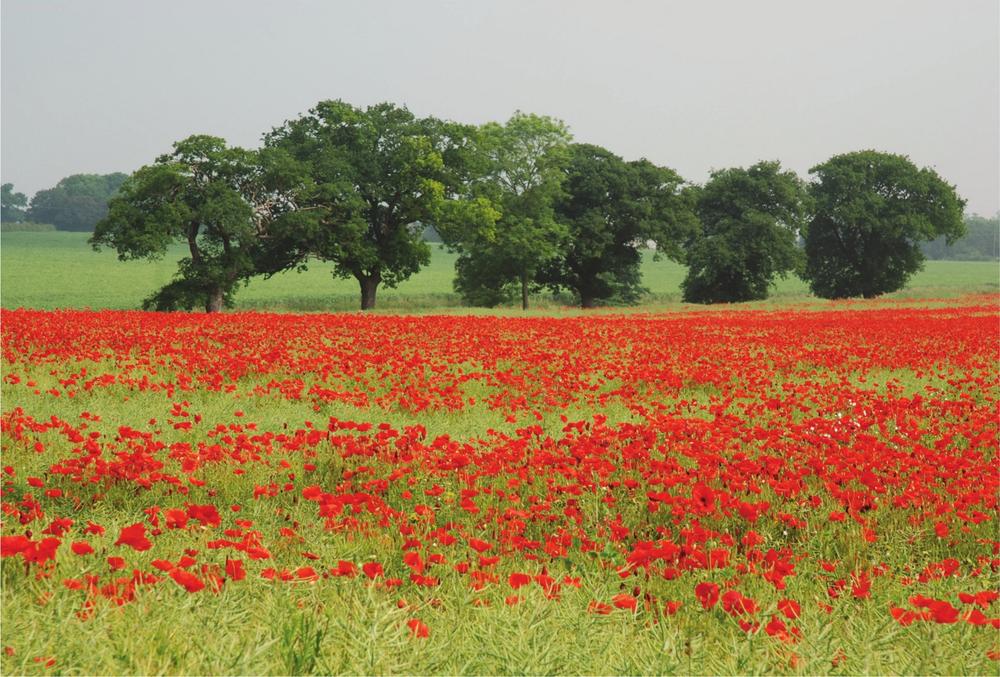
Herbal sweets
While we are not recommending large amounts of sugar as being healthy, herbal sweets such as coltsfoot rock and peppermints are a traditional way of taking herbs in a pleasurable way.
Plant essences
Plant essences, usually flower essences, differ from other herbal preparations in that they only contain the vibrational energy of the plant, and none of the plant chemistry. To make an essence, the flowers or other plant parts are usually put in water in a glass bowl and left to infuse in the sun for a couple of hours, as in the instructions for our self-heal essence. This essence is then preserved with brandy, and diluted for use.
Infused oils
Oil is mostly used to extract plants for external use on the skin, but infused oils can equally well be taken internally. Like vinegars, they are good in salad dressings and in cooking.
We prefer extra virgin olive oil as a base, as it does not go rancid like many polyunsaturated oils do. Other oils, such as coconut and sesame, may be chosen because of their individual characteristics.
Infused oils are also known as macerated oils, and should not be confused with essential oils, which are aromatic oils isolated by distilling the plant material.
Ointments or salves
Ointments or salves are rubbed onto the skin. The simplest ointments are made by adding beeswax to an infused oil and heating until the beeswax has melted. The amount of wax needed will vary, depending on the climate or temperature in which it will be used, with more wax needed in hotter climates or weather.
Ointments made this way have a very good shelf life. They absorb well, while providing a protective layer on top of the skin.
Ointments can also be made with animal fats or hard plant fats such as cocoa butter.
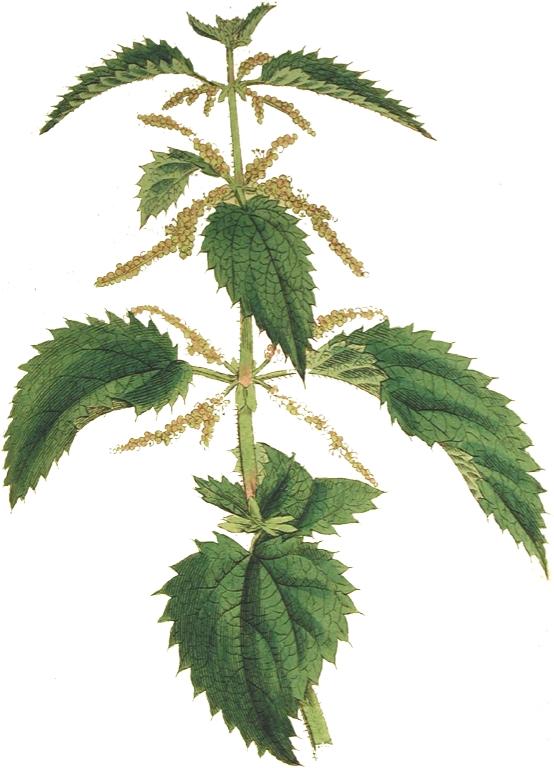
Nettle, from Woodville’s Medical Botany (1790–3)
Butters and ghees
Butter can be used instead of oil to extract herbs, and, once clarified by simmering, it keeps well without refrigeration, making a simple ointment. Clarified butter is a staple in Indian cooking and medicine, where it is called ghee. It is soothing on the skin and absorbs well. Herbal butters and ghees can also be used as food.
Skin creams
Creams are a mixture of a water-based preparation with an oil-based one, to make an emulsion. Creams are absorbed into the skin more rapidly than ointments, but have the disadvantages of being more difficult to make and not keeping as well. Essential oils can be added to help preserve creams, and they keep best if refrigerated.
Poultices
The simplest poultice is mashed fresh herb put on to the skin, as when you crush a ribwort leaf and apply it to a wasp sting. Poultices can be made from fresh herb juice mixed with slippery elm powder or simply flour, or from dried herb moistened with hot water or vinegar.
Change the poultice every few hours and keep it in place with a bandage or sticking plaster.
Fomentations or compresses
A fomentation or compress is an infusion or a decoction applied externally. Simply soak a flannel or bandage in the warm or cold liquid, and apply. Hot fomentations are used to disperse and clear, and are good for conditions as varied as backache, joint pain, boils and acne. Hot fomentations need to be refreshed frequently once they cool down.
Cold fomentations can be used for cases of inflammation or for headaches. Alternating hot and cold fomentations works well for sprains and other injuries.
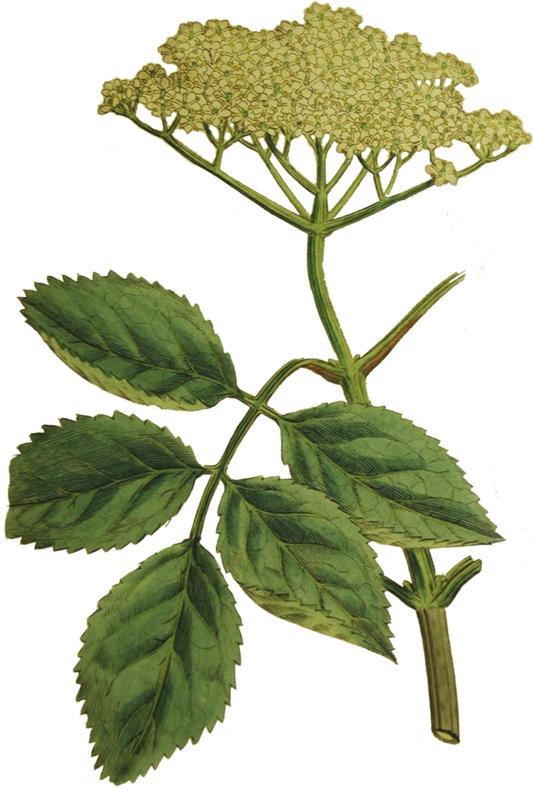
Elderflower, from Woodville’s Medical Botany (1790–3);
Embrocations or liniments
Embrocations or liniments are used in massage, with the herbs in an oil or alcohol base or a mixture of the two. Absorbed quickly through the skin, they can readily relieve muscle tension, pain and inflammation, and speed the healing of injuries.
Baths
Herbs can be added conveniently to bathwater by tying a sock or cloth full of dried or fresh herb to the hot tap as you run the bath, or by adding a few cups of an infusion or decoction. Herbal vinegars and oils can also be added to bath water, as can essential oils.
Besides full baths, hand and foot baths can be very effective, as can sitz or hip baths where only your bottom is in the water.
Douches
Herbal infusions or decoctions can be used once they have cooled as douches for vaginal infections or inflammation.